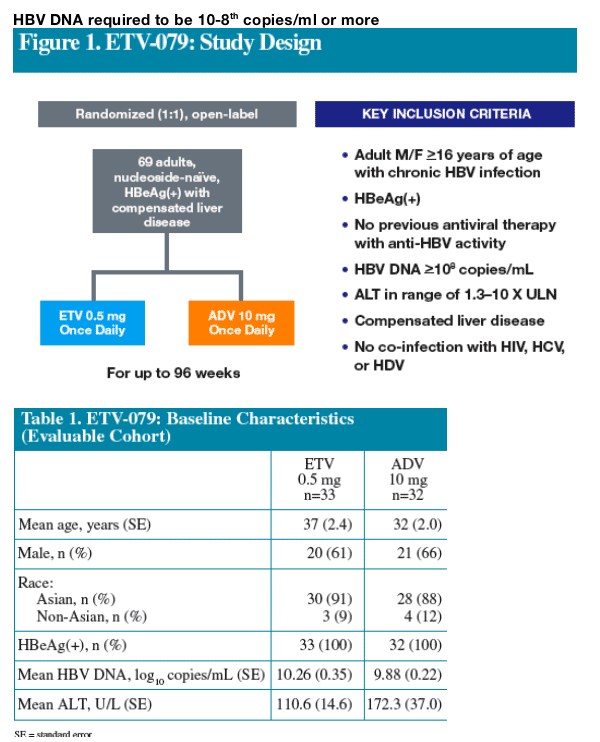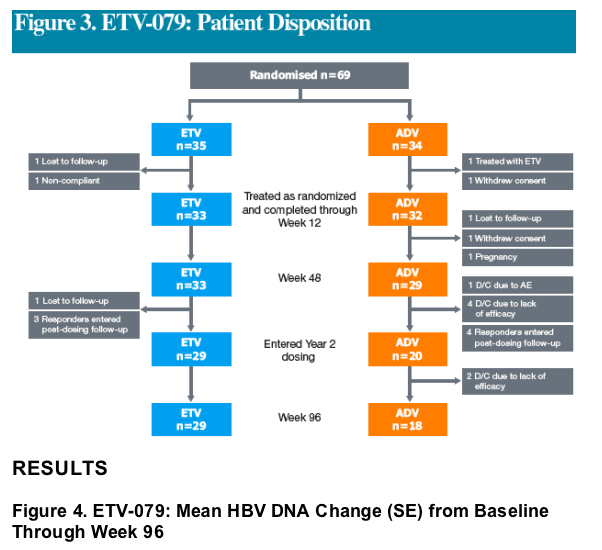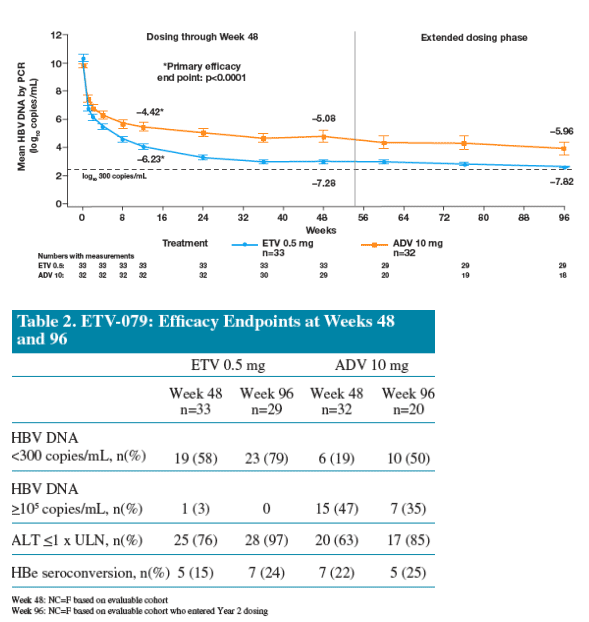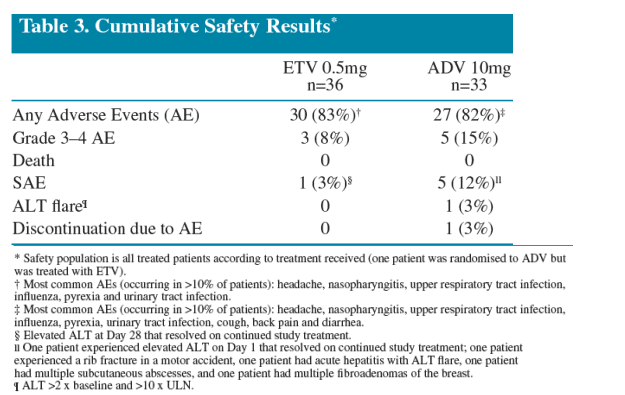 |
 |
 |
| |
Entecavir (ETV) Results in Higher HBV DNA Reduction versus Adefovir (ADV) in Antiviral-naive HBeAg(+) Adults with High HBV DNA: Week 96 Results (E.A.R.L.Y. Study)
|
| |
| |
Reported by Jules Levin
43rd EASL April23-27, 2008
Milan, Italy
N Leung1, C-Y Peng2, J Sollano3, L Lesmana4, M-F Yuen5, L Jeffers6, H-W Hann7, M Sherman8, U Diva9, K Mencarini9, A Cross9, R Wilber9 and JC Lopez-Talavera9 for the Entecavir Viral Kinetics Group
1 Alice Ho Miu Ling Nethersole Hospital, Hong Kong, China; 2 China Medical University Hospital, Taichung, Taiwan; 3 Santo Tomas University Hospital, Manila, Philippines; 4 Cipto Mangunkusumo National Central General Hospital, Jakarta, Indonesia; 5 Queen Mary Hospital, Pok Fu Lam, Hong Kong, China;
6 University of Miami Center for Liver Diseases, Miami, Florida, USA; 7 Liver Disease Prevention Center, Division of Gastroenterology and Hepatology, Thomas Jefferson University Hospital, Philadelphia, USA; 8 Toronto General Hospital, Toronto, Canada; 9 Bristol-Myers Squibb Pharmaceutical Research Institute, Wallingford, CT, USA
AUTHOR CONCLUSIONS
ETV 0.5 mg was superior to ADV 10 mg for the primary efficacy endpoint of viral load reduction at Week 12
The difference in mean HBV DNA change from baseline was significantly higher with ETV as early as Day 10, and maintained through Week 96
Fewer ETV-treated patients discontinued therapy than ADV-treated patients
At Week 96, 23/29 (79%) of ETV-treated patients achieved HBV DNA <300 copies/mL, compared to 10/20 (50%) of ADV-treated patients
At Week 96, a higher proportion of ADV-treated patients exhibited HBV DNA >105 copies/mL than ETV-treated patients
ETV was well-tolerated
Background
Elevated HBV DNA is associated with increased risk of disease progression and complications, including hepatocellular carcinoma (HCC), in patients with chronic hepatitis B infection (CHB)1
Antiviral strategies should aim at rapid and extensive reduction of HBV DNA to the lowest levels possible2
Entecavir (ETV) is a potent guanosine analogue which has demonstrated superior virological, histological, and biochemical efficacy compared to lamivudine in phase 3 studies of patients with CHB3,4
Previously presented results of the ETV-079 (E.A.R.L.Y.) study demonstrated the superiority of ETV over adefovir (ADV) for HBV DNA reduction at Week 12 (primary endpoint)5
ETV also demonstrated a more rapid viral load reduction compared to ADV, with a significant difference noted as early as Day 105
The difference in antiviral effect between ETV and ADV was maintained through Week 486
STUDY OBJECTIVES
Primary
Demonstrate ETV has superior early antiviral efficacy at
Week 12
- Measured by mean change in serum HBV DNA levels (PCR log10 copies/mL)
Secondary
HBV kinetics through Week 12
Mean HBV DNA change from baseline through Week 96
Proportions of patients in each treatment group who achieved
- HBV DNA <300 copies/mL
- ALT <1 X ULN
- HBeAg loss and HBe seroconversion
Safety
HBV DNA required to be 10-8th copies/ml or more

Methods
HBV DNA assayed by Roche COBAS PCR on Days 1-14, and at Weeks 3, 4, 6, 8, 10, 12, 24, 36, 48, 60, 76 and 96
Efficacy analyses used the 'evaluable cohort', defined as patients who received randomised therapy for a minimum of 12 weeks and had HBV DNA measurements by PCR assay at both baseline and Week 12
The Week 96 analysis is based on the subset of the 'evaluable cohort' who entered Year 2 dosing
Mean change from baseline HBV DNA by PCR are estimated from subjects with available measurements
For analysis of HBV DNA by PCR endpoints (<300 copies/mL; >105 copies/mL), ALT <1 x ULN and serology endpoints, patients who discontinued before Week 48, or after Week 48 and before Week 96, were considered failures (Non-Completer = Failure: NC = F method)
Safety data is reported for patients as-treated


At 96 weeks:
- A higher proportion of ETV-treated patients achieved HBV DNA < 300 copies/mL than ADV-treated patients
- A higher proportion of ADV-treated patients exhibited HBV DNA > 105 copies/mL than ETV-treated patients
- Similar proportions of ETV- and ADV-treated patients achieved ALT normalisation and HBe seroconversion
-- A higher proportion of ETV-treated patients completed study participation

References
1. Chen CJ, et al. JAMA. 2006; 295:65-73.
2. Keefe EB, et al. Clin Gast Hep. 2006;4:936-962.
3. Chang TT, et al. N Engl J Med. 2006;354:1001-1010.
4. Lai CL, et al. N Engl J Med. 2006;354:1011-1017.
5. Sherman M, et al. J Clin Vir. 2006:36(Suppl 2): S239.
6. Leung N, et al. J Hepatol. 2007:46(Suppl 1): S24.
|
| |
|
 |
 |
|
|